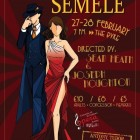Semele 2017University of St Andrews Opera Society
Read more about the opera Semele
It is encouraging to see a new student group, the University of St Andrews Opera Society, being established in this day and age, when so many bands of enthusiastic amateurs have fallen by the wayside. Any work by Handel would signify a certain level of ambition, and the choice of Semele, with its witty text by the Restoration master William Congreve, is a clear indication of the ambition and confidence of these students.
The foundation of such a setup must be its orchestra and chorus. The band of sixteen, directed from the harpsichord by Sean Heath, showed remarkable accomplishment and an excellent sense of style throughout. The chorus (also sixteen) succeeded in projecting their words clearly. While some did not seem entirely at ease on stage, that will no doubt improve with practice.
The soloists in the major roles did well. The mezzo parts of Juno and Ino are traditionally played by one singer - an important element of the comedy being derived from the scene where the furious goddess takes the form of Semele's sister in order to trick the heroine. Here were two very good mezzos who were of similar stature, so the exchange worked well enough to justify casting two singers in the parts. A third mezzo made an impact in the early scenes as Athamas, who is loved by Ino but actually engaged, briefly, to Semele.
Christina Bell made an excellent impression in the title role, exhibiting a beautifully sweet-toned soprano in her varied group of arias. At the second performance, Andrew Mundy took a few minutes to settle, but thereafter revealed a neat tenor that suited the dimensions of the Byre well.
With the band occupying the left side of the stage, the props were minimalist but perfectly adequate. The direction of Joseph Houghton worked tactfully, though the expressed setting - early 1920s Manhattan - didn't come over with any particular focus. This was a distinctly successful first full opera staging by this new group.
